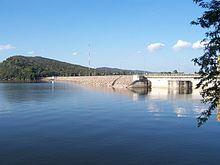Ubol Ratana Dam
| Ubol Ratana Dam | |
|---|---|
 Upstream side of dam | |
| Official name | Ubol Ratana Dam |
| Country | Thailand |
| Location | Ubolratana, Khon Kaen |
| Coordinates | 16°46′31.42″N 102°37′5.97″E / 16.7753944°N 102.6183250°E |
| Opening date | 1966 |
| Owner(s) | Electricity Generating Authority of Thailand |
| Dam and spillways | |
| Type of dam | Earth core rock-fill dam |
| Impounds | Phong River |
| Height | 32 m (105 ft) |
| Length | 885 m (2,904 ft) |
| Reservoir | |
| Creates | Ubol Ratana Reservoir |
| Total capacity | 2,263,000 m3 (79,900,000 cu ft) |
| Catchment area | 12,104 km2 (4,673 sq mi) |
| Power Station | |
| Operator(s) | Electricity Generating Authority of Thailand |
| Turbines | 3 x 8.4 MW Kaplan-type |
| Installed capacity | 25.2 MW |
| Annual generation | 57 GWh |
The Ubol Ratana Dam (pronounced: Ubon Rat), formerly known as the "Phong Neeb Dam", is a multi-purpose dam in tambon Khok Sung, Ubolratana district, approximately 50 km (31 mi) north of Khon Kaen, Khon Kaen province, Thailand. It was the first hydroelectric power project developed in Thailand's northeastern area of Isan.[1] The dam impounds the Nam Phong, which flows into the Chi River and thence to the Mun River, a tributary of the Mekong River. The dam was given its current name by royal permission in 1966, in honour of princess Ubol Ratana, the eldest child of King Bhumibol Adulyadej.
Description

The dam is multi-purpose: electricity generation, irrigation, flood control, transportation, fisheries, and as tourist attraction.[2] It is an earth core rockfill dam, constructed in 1964. Its crest length is 885 m (2,904 ft), and 32 m (105 ft) high. Its catchment area is 12,104 km2 (4,673 sq mi). Its reservoir has a maximum storage capacity of 2,263,000 m3 (79,900,000 cu ft).[3]
The dam is managed by the Electricity Generating Authority of Thailand (EGAT).
Thirty thousand people were resettled to make way for the large reservoir accompanying the dam. This resettlement resulted in a sharp decrease in forested areas in the catchment areas and an increase in erosion.
In 1984, the dam was modified to reinforce dam safety and to ensure better flood protection.
In 2024, a 24 MW floating solar PV array of approximately 48,000 [4] panels was added. Electricity generation during sunlight hours is now typically solar powered, while hydro electric generation can be reserved primarily at night. Additionally, a 6 MWh [4] BESS (Battery Electric Storage System) was added to provide power when switching between the two sources of generation. [5]
Power plant
The power plant at the dam has three turbines, each with an installed capacity of 8,400 KW. The dam generates an average of 57 GWh a year. The operation of the turbines commenced on 4 February 1966, 14 March 1969, and 12 June 1968 respectively.[2]
History
In April 2016 the dam ran dry for the first time since its construction. With no usable storage it cannot provide irrigation water, cannot generate electricity, and its fish population is dying. Its usable storage stands at minus 3.95 percent (as of (2016-04-04).[6]
Ubol Ratana Dam is the first of the royal dams to run dry. The other royal dams are:[1]
- Bhumibol Dam: opened in 1964 in the north on the Ping River. Capacity: 13,462,000,000 m3.
- Sirindhorn Dam: opened in 1971 in the northeast on the Lam Dom Noi River. Capacity: 1,966,000,000 m3
- Chulabhorn Dam: opened in 1972 in the northeast on the Phrong River. Capacity: 165,000,000 m3
- Sirikit Dam: opened in 1974 in the north on the Nan River. Capacity: 9,510,000,000 m3
- Srinagarind Dam: opened in 1980 in the west on the Khwae Yai River. Capacity: 17,745,000,000 m3
- Vajiralongkorn Dam: opened in 1984 in the west on the Khwae Noi River. Capacity: 8,100,000 m3
Due to the ongoing drought, the royal dams are heavily stressed. According to the Hydro and Agro Informatics Institute, as of 3 April 2016, sixteen Thai dams are at critically low levels of usable reservoir storage. Of the other royal dams, Bhumibol Dam is at four percent, Sirindhorn Dam is at 10 percent, Srinagarind Dam is at 11 percent, Sirikit Dam is at 12 percent, Chulabhorn Dam is at 13 percent, and Vajiralongkorn Dam is at 14 percent.[1]
See also
References
- ^ a b c Draper, John (2016-04-04). "A Royal Dam Runs Dry". Prachatai English. Retrieved 5 April 2016.
- ^ a b "Renovation of Small Hydropower Plants by Hydropower Construction Division in 2005". Electricity Generating Authority of Thailand. Archived from the original on 2010-01-14. Retrieved 2011-01-30.
- ^ "Ubol Ratana Dam". Electricity Generating Authority of Thailand (EGAT). Retrieved 5 April 2016.
- ^ a b "กฟผ. เร่งเดินหน้าโซลาร์เซลล์ลอยน้ำไฮบริดเขื่อนอุบลรัตน์ ผลิตไฟฟ้าสีเขียวตอบโจทย์เทรนด์โลก". www.egat.co.th (in Thai). 2023-12-21. Archived from the original on 2024-03-31. Retrieved 2024-03-31.
- ^ "Hydro-floating Solar Hybrid at Ubol Ratana Dam starts commercial operation, driving Thailand toward Carbon Neutrality". EGAT - Electricity Generating Authority of Thailand. 2024-03-06. Archived from the original on 2024-03-23. Retrieved 2024-03-23.
- ^ "Report of EGAT reservoir storage conditions". Thaiwater.net. Hydro and Agro Informatics Institute (HAII). 2016-04-04. Retrieved 5 April 2016.
External links
- CGIAR Challenge Program on Water and Food-Mekong Archived 2012-04-28 at the Wayback Machine
- Thailand National Mekong Committee Archived 2019-11-22 at the Wayback Machine
- Electricity Generating Authority of Thailand Archived 2018-01-26 at the Wayback Machine
- Mekong Program on Water, Environment and Resilience
- Mekong River Commission

